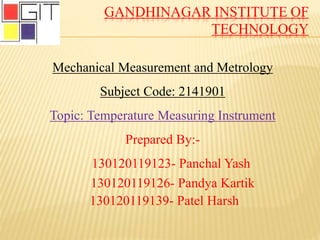
Mmm 123 126-139
- 1. GANDHINAGAR INSTITUTE OF TECHNOLOGY Mechanical Measurement and Metrology Subject Code: 2141901 Topic: Temperature Measuring Instrument Prepared By:- 130120119123- Panchal Yash 130120119126- Pandya Kartik 130120119139- Patel Harsh
- 2. INTRODUCTION The accurate measurement of temperature is vital across abroad spectrum of human activities, Including industrial processes (e.g. making steel) Manufacturing; Monitoring (in food transport and storage), Health and safety. In fact, in almost every sector, temperature is one of the key parameters to be measured
- 3. The means of accurately measuring temperatures has long fascinated people. One of the differences between temperature and other physical concepts, such as mass or length, is that it is subjective. Different people will have different perceptions of what is hot and what is cold. To make objective measurements, we must use thermometer in which some physical property of a substance changes with temperature in a reliable and reproducible way.
- 4. SCALE Temperature is a measure of the thermal energy in the body. Normally measured in degrees [°]using one of the following scales. 1. Fahrenheit.[°F] 2. Celsius or centigrade. [°C] 3. Kelvin .[°K]
- 6. 1.Bulb: The reservoir for containing most of the thermometric liquid (mercury). 2.Stem: The glass tube having a capillary bore along which the liquid moves with changes in temperature. 3. Scale: A narrow-temperature-range scale for reading a reference temperature . Construction 1.Liquid – in – Glass Thermometer
- 7. The volume of mercury changes slightly with temperature; the small change in volume drives the narrow mercury column a relatively long way up the tube. The space above the mercury may be filled with nitrogen or it may be at less than atmospheric pressure, a partial vacuum.
- 8. 2.BIMETALLIC THERMOMETER In an industry, there is always a need to measure and monitor temperature of a particular spot, field or locality. The industrial names given to such temperature sensors are Temperature Indicators (TI) or Temperature Gauges (TG). All these temperature gauges belong to the class of instruments that are known as bimetallic sensors.
- 9. BIMETALLIC THERMOMETER Two basic principles of operation is to be followed in the case of a bimetallic sensor. 1) A metal tends to undergo a volumetric dimensional change (expansion/contraction), according to the change in temperature. 2) Different metals have different co-efficient of temperatures. The rate of volumetric change depends on this co-efficient of temperature.
- 10. Construction
- 11. The device consists of a bimetallic strip of two different metals . They are bonded together to form a spiral or a twisted helix. Both these metals are joined together at one end by either welding or riveting. It is bonded so strong that there will not be any relative motion between the two. The image of a bimetallic strip is shown below.
- 13. CONSTRUCTION A change in temperature causes the free end of the strip to expand or contract due to the different coefficients of expansion of the two metals. This movement is linear to the change in temperature and the deflection of the free end can be read out by attaching a pointer to it. This reading will indicate the value of temperature. Bimetallic strips are available in different forms like helix type, cantilever, spiral, and also flat type.
- 14. PRESSURE THERMOMETER 1. Liquid Pressure Thermometers. 2. Vapour Pressure Thermometers.
- 17. PYROMETER A pyrometer is a device that is used for the temperature measurement of an object. The device actually tracks and measures the amount of heat that is radiated from an object. The thermal heat radiates from the object to the optical system present inside the pyrometer. The optical system makes the thermal radiation into a better focus and passes it to the detector.
- 18. In an optical pyrometer, a brightness comparison is made to measure the temperature. The device compares the brightness produced by the radiation of the object whose temperature is to be measured, For an object, its light intensity always depends on the temperature of the object. After adjusting the temperature, the current passing through it is measured using a multimeter, as its value will be proportional to the temperature of the source when calibrated. The working of an optical pyrometer is shown in the figure below.
- 20. As shown in the figure above, an optical pyrometer has the following components. 1. An eye piece at the left side and an optical lens on the right. 2. A reference lamp, which is powered with the help of a battery. 3. A rheostat to change the current and hence the brightness intensity. 4. So as to increase the temperature range which is to be measured, an absorption screen is fitted between the optical lens and the reference bulb.
- 21. Working 1.The radiation from the source is emitted and the optical objective lens captures it. 2.The lens helps in focusing the thermal radiation on to the reference bulb. 3.The observer watches the process through the eye piece and corrects it in such a manner that the reference lamp filament has a sharp focus and the filament is super-imposed on the temperature source image. 4.The observer starts changing the rheostat values and the current in the reference lamp changes. 5.This in turn, changes its intensity. This change in current can be observed in three different ways.
- 22. The filament is dark. That is, cooler than the temperature source. Filament is bright. That is, hotter than the temperature source. Filament disappears. Thus, there is equal brightness between the filament and temperature source
- 23. At this time, the current that flows in the reference lamp is measured, as its value is a measure of the temperature of the radiated light in the temperature source, when calibrated.
- 24. Applications 1. Used to measure temperatures of liquid metals or highly heated materials. 2. Can be used to measure furnace temperatures.
- 26. CONCLUSION From This Instruments we can measure temperature of different objects..
- 27. Thank You
